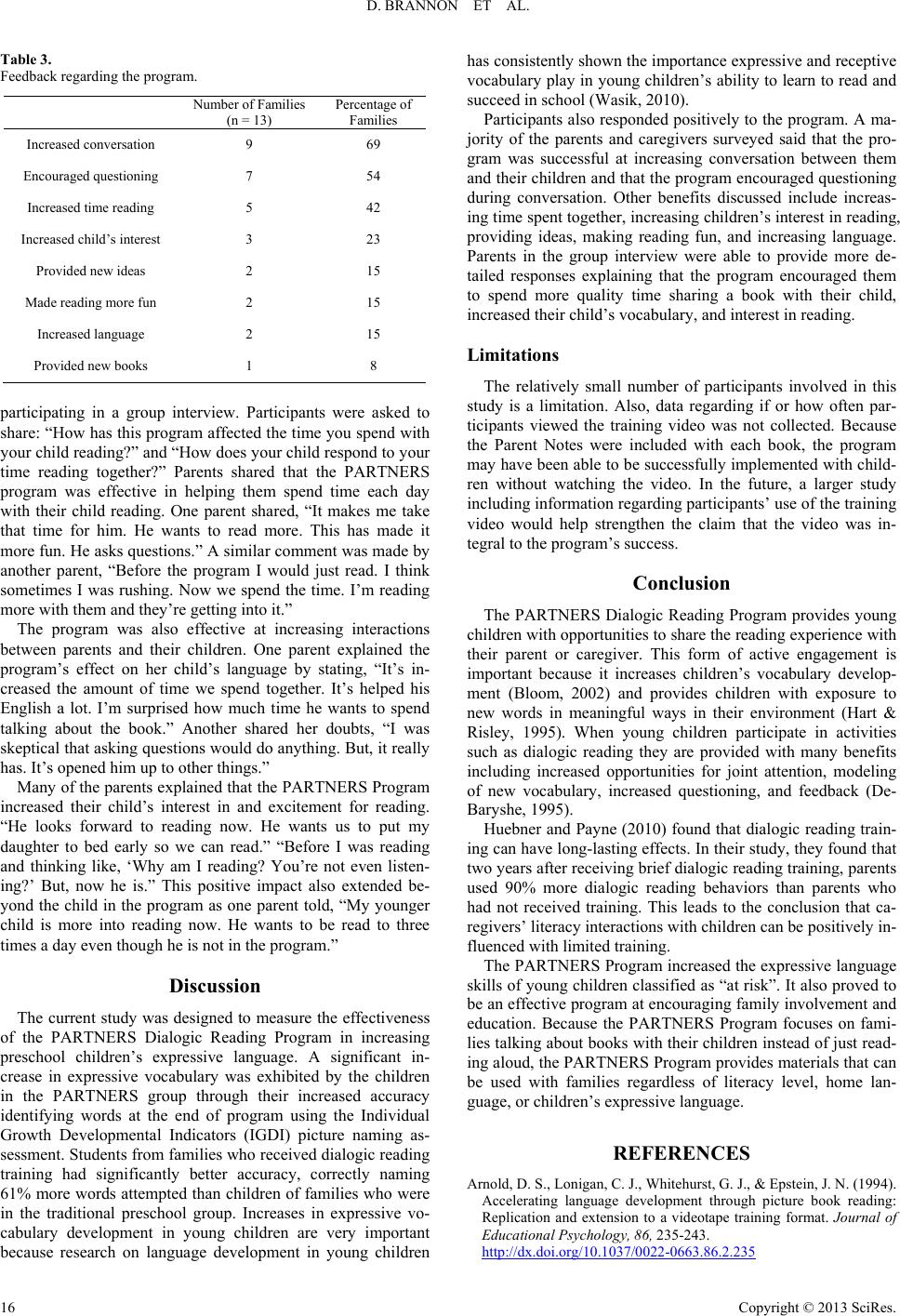
D. BRANNON ET AL.
Copyright © 2013 SciRes.
Table 3.
Feedback regarding the program.
Number of Families
(n = 13) Percentage of
Families
Increased conversation 9 69
Encouraged questioning 7 54
Increased time reading 5 42
Increased child’s interest 3 23
Provided ne w ideas 2 15
Made reading more fun 2 15
Increased language 2 15
Provided new books 1 8
participating in a group interview. Participants were asked to
share: “How has this program affected the time you spend with
your child reading?” and “How does your child respond to your
time reading together?” Parents shared that the PARTNERS
program was effective in helping them spend time each day
with their child reading. One parent shared, “It makes me take
that time for him. He wants to read more. This has made it
more fun. He asks questions.” A similar comment was made by
another parent, “Before the program I would just read. I think
sometimes I was rushing. Now we spend the time. I’m reading
more with them and they’re getting into it.”
The program was also effective at increasing interactions
between parents and their children. One parent explained the
program’s effect on her child’s language by stating, “It’s in-
creased the amount of time we spend together. It’s helped his
English a lot. I’m surprised how much time he wants to spend
talking about the book.” Another shared her doubts, “I was
skeptical that asking questions would do anything. But, it rea lly
has. It’s opened him up to other things.”
Many of the parents explained that the PARTNERS Program
increased their child’s interest in and excitement for reading.
“He looks forward to reading now. He wants us to put my
daughter to bed early so we can read.” “Before I was reading
and thinking like, ‘Why am I reading? You’re not even listen-
ing? ’ But, now he is.” This positive impact also extended be-
yond the child in the program as one parent told, “My younger
child is more into reading now. He wants to be read to three
times a day even though he is not in the program.”
Discussion
The current study was designed to measure the effectiveness
of the PARTNERS Dialogic Reading Program in increasing
preschool children’s expressive language. A significant in-
crease in expressive vocabulary was exhibited by the children
in the PARTNERS group through their increased accuracy
identifying words at the end of program using the Individual
Growth Developmental Indicators (IGDI) picture naming as-
sessment. Students from families who received dialogic reading
training had significantly better accuracy, correctly naming
61% more words attempted than children of families who were
in the traditional preschool group. Increases in expressive vo-
cabulary development in young children are very important
because research on language development in young children
has consistently shown the importance expressive and receptive
vocabulary play in young children’s ability to learn to rea d and
succeed in school (Wasik, 2010).
Participants also responded positively to the program. A ma-
jority of the parents and caregivers surveyed said that the pro-
gram was successful at increasing conversation between them
and their children and that the program encouraged questioning
during conversation. Other benefits discussed include increas-
ing time spent together, increasing children’s interest in reading,
providing ideas, making reading fun, and increasing language.
Parents in the group interview were able to provide more de-
tailed responses explaining that the program encouraged them
to spend more quality time sharing a book with their child,
increased their child’s vocabulary, and interest in reading.
Limitations
The relatively small number of participants involved in this
study is a limitation. Also, data regarding if or how often par-
ticipants viewed the training video was not collected. Because
the Parent Notes were included with each book, the program
may have been able to be successfully implemented wit h child-
ren without watching the video. In the future, a larger study
including information regarding participants’ use of the training
video would help strengthen the claim that the video was in-
tegral to the program’s success.
Conclusion
The PARTNERS Dialogic Reading Program provides young
children with opportunities to share the reading experience with
their parent or caregiver. This form of active engagement is
important because it increases children’s vocabulary develop-
ment (Bloom, 2002) and provides children with exposure to
new words in meaningful ways in their environment (Hart &
Risley, 1995). When young children participate in activities
such as dialogic reading they are provided with many benefits
including increased opportunities for joint attention, modeling
of new vocabulary, increased questioning, and feedback (De-
Baryshe, 1995).
Huebner and Payne (2010) found that dialogic reading train-
ing can have long-lasting effects. In their study, they found that
two years after receiving brief dialogic reading training, parents
used 90% more dialogic reading behaviors than parents who
had not received training. This leads to the conclusion that ca-
regivers’ literacy interactions with children can be positively in-
fluenced with limite d traini ng.
The PARTNERS Program increased the expressive language
skills of young children classified as “at risk”. It also proved to
be an effective program at encouraging family involvement and
education. Because the PARTNERS Program focuses on fami-
lies talking about books with their children instead of just read-
ing aloud, the PARTNERS Program provides materials that can
be used with families regardless of literacy level, home lan-
guage, or children’s expressive language.
REFERENCES
Arnold, D. S., Lonigan, C. J., Whitehurst, G. J., & Epstein, J. N. (1994).
Accelerating language development through picture book reading:
Replication and extension to a videotape training format. Journal of
Educational Psychology, 86, 235-243.
http://dx.doi.org/10.1037/0022-0663.86.2.235